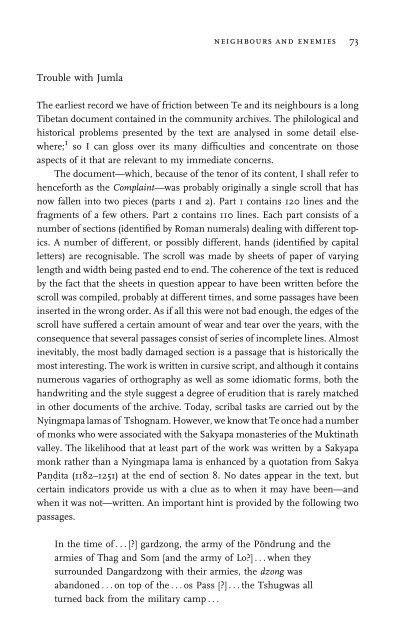Navel of the Demoness : Tibetan Buddhism and Civil Religion in ...
Navel of the Demoness : Tibetan Buddhism and Civil Religion in ...
Navel of the Demoness : Tibetan Buddhism and Civil Religion in ...
Create successful ePaper yourself
Turn your PDF publications into a flip-book with our unique Google optimized e-Paper software.
<strong>the</strong> people <strong>of</strong> mustang <strong>and</strong> <strong>the</strong>ir history 31<br />
was closed to foreigners before 1991, s<strong>in</strong>ce which time limited numbers <strong>of</strong><br />
tourists have been permitted to travel <strong>the</strong>re on payment <strong>of</strong> a substantial royalty.<br />
The l<strong>in</strong>e corresponds to no traditional boundary between old adm<strong>in</strong>istrative<br />
entities or ethnically dist<strong>in</strong>ct groups but seems to be largely a matter <strong>of</strong> supervisory<br />
convenience: <strong>the</strong> last settlement on <strong>the</strong> Kali G<strong>and</strong>aki with<strong>in</strong> <strong>the</strong><br />
unrestricted part <strong>of</strong> Mustang is Kag (Nep. Kagbeni), which was long ago favoured<br />
by <strong>the</strong> local rulers as <strong>the</strong> site <strong>of</strong> a customs post, s<strong>in</strong>ce its geographical<br />
situation permitted a clear view <strong>of</strong> travellers up <strong>and</strong> down <strong>the</strong> ma<strong>in</strong> trade route.<br />
Mustang district is made up <strong>of</strong> a number <strong>of</strong> enclaves that are recognised<br />
ei<strong>the</strong>r as <strong>the</strong> residues <strong>of</strong> old adm<strong>in</strong>istrative entities or <strong>the</strong> territories <strong>of</strong> ethnically<br />
dist<strong>in</strong>ct groups. The nor<strong>the</strong>rnmost part, as we have seen, is referred to as<br />
Lo. Upper Lo is <strong>the</strong> territory that was ruled by <strong>the</strong> k<strong>in</strong>g <strong>of</strong> Mustang at <strong>the</strong> time<br />
<strong>of</strong> <strong>the</strong> unification, <strong>and</strong> recognised by <strong>the</strong> Gorkhas as his doma<strong>in</strong>. The area is<br />
referred to more fully as Lotö Tshodun (Tib. Glo bo stod tsho bdun), ‘‘<strong>the</strong> Seven<br />
Sectors <strong>of</strong> Upper Lo.’’ The word tsho (Tib. tsho), which I have translated here as<br />
‘‘sector,’’ is an old <strong>Tibetan</strong> adm<strong>in</strong>istrative division that might be better rendered<br />
as ‘‘county’’ here; however, s<strong>in</strong>ce we shall later encounter <strong>the</strong> same word be<strong>in</strong>g<br />
used to signify subdivisions with<strong>in</strong> <strong>in</strong>dividual settlements, as well as assemblies<br />
<strong>of</strong> people, <strong>the</strong> vaguer ‘‘sector’’ is probably more appropriate. Each <strong>of</strong> <strong>the</strong><br />
seven sectors conta<strong>in</strong>s one or more settlements. Larger communities, like <strong>the</strong><br />
city <strong>of</strong> Monthang, account for an entire sector, while o<strong>the</strong>r sectors consist <strong>of</strong><br />
several small villages that have been grouped toge<strong>the</strong>r. It is likely that <strong>the</strong>se<br />
sectors were above all tax-pay<strong>in</strong>g units, with all sectors be<strong>in</strong>g required to pay<br />
<strong>the</strong> same amount <strong>in</strong> terms <strong>of</strong> cash or o<strong>the</strong>r commodities. How a sector would<br />
organise <strong>the</strong> distribution <strong>of</strong> its tax burden among its component settlements or<br />
houses seems to have been largely its own affair.<br />
Below Gemi, <strong>the</strong> sou<strong>the</strong>rnmost village <strong>in</strong> Upper Lo, is <strong>the</strong> large community<br />
<strong>of</strong> Gelung, which (with <strong>the</strong> help <strong>of</strong> Jumla) broke away from <strong>the</strong> k<strong>in</strong>gdom<br />
<strong>in</strong> <strong>the</strong> 1754 (Schuh 1994: 85). Immediately to <strong>the</strong> south <strong>of</strong> Gelung is Baragaon,<br />
correspond<strong>in</strong>g to <strong>the</strong> region I have referred to earlier as Lower Lo. S<strong>in</strong>ce <strong>the</strong><br />
latter is sometimes used <strong>in</strong> <strong>Tibetan</strong> works to <strong>in</strong>clude areas even fur<strong>the</strong>r south,<br />
I shall ab<strong>and</strong>on <strong>the</strong> name altoge<strong>the</strong>r <strong>in</strong> favour <strong>of</strong> <strong>the</strong> unambiguous Baragaon.<br />
Baragaon (Nep. Bahragaũ) now is made up <strong>of</strong> n<strong>in</strong>eteen settlements that, with<br />
<strong>the</strong> exception <strong>of</strong> five villages, are all <strong>Tibetan</strong>-speak<strong>in</strong>g. S<strong>in</strong>ce it is Baragaon <strong>and</strong>,<br />
more particularly, <strong>the</strong> five non-<strong>Tibetan</strong>-speak<strong>in</strong>g villages that are <strong>the</strong> ma<strong>in</strong><br />
concern <strong>of</strong> this book, I shall return to this enclave later <strong>and</strong> cont<strong>in</strong>ue for now<br />
with a rough sketch <strong>of</strong> Mustang as a whole.<br />
South <strong>of</strong> Baragaon is a group <strong>of</strong> settlements known as Panchgaon (Nep.<br />
Pancgaũ), a Nepali name that has its <strong>Tibetan</strong> equivalent Yulkhanga (Yul kha<br />
lnga). Both terms mean ‘‘<strong>the</strong> Five Villages.’’ The villages are Th<strong>in</strong>i, Shang,


